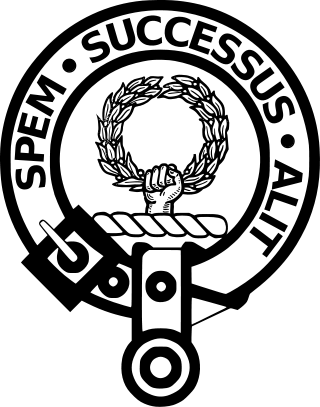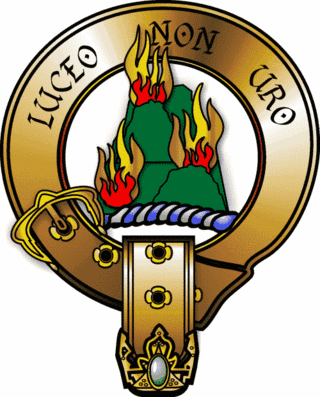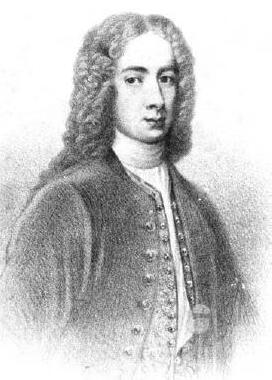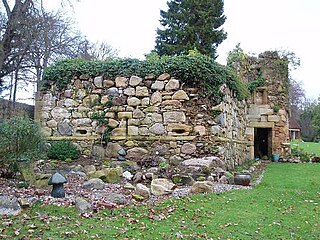
Clan Ross is a Highland Scottish clan. The original chiefs of the clan were the original Earls of Ross.

Earl of Cromartie is a title that has been created twice, both for members of the Mackenzie family. It was first created as Earl of Cromarty in the Peerage of Scotland in 1703 for Sir George Mackenzie, 2nd Baronet, but his titles were forfeited after the Jacobite rising of 1745. It was recreated in 1861 in the Peerage of the United Kingdom for Anne Sutherland-Leveson-Gower, Duchess of Sutherland. Since 1979, the Earl of Cromartie has been chief of Clan Mackenzie.

Clan Mackenzie is a Scottish clan, traditionally associated with Kintail and lands in Ross-shire in the Scottish Highlands. Traditional genealogies trace the ancestors of the Mackenzie chiefs to the 12th century. However, the earliest Mackenzie chief recorded by contemporary evidence is Alexander Mackenzie of Kintail who died some time after 1471. Traditionally, during the Wars of Scottish Independence, the Mackenzies supported Robert the Bruce, but feuded with the Earls of Ross in the latter part of the 14th century. During the 15th and 16th-centuries the Mackenzies feuded with the neighboring clans of Munro and MacDonald. In the 17th century the Mackenzie chief was made Earl of Seaforth in the peerage of Scotland. During the Scottish Civil War of the 17th century the Mackenzies largely supported the Royalists. During the Jacobite rising of 1715 the chief and clan of Mackenzie supported the Jacobite cause. However, during the Jacobite rising of 1745 the clan was divided with the chief, Kenneth Mackenzie, Lord Fortrose, supporting the British-Hanoverian Government and his relative, George Mackenzie, 3rd Earl of Cromartie, supporting the Jacobites.
Strathpeffer is a village and spa town in Ross and Cromarty, Highland, Scotland, with a population of 1,469.

George Mackenzie, 1st Earl of Cromartie FRS (1630–1714), known as Sir George Mackenzie, 2nd Baronet from 1654 to 1685 and as The Viscount of Tarbat from 1685 to 1703, was a Scottish statesman.

George Mackenzie, 3rd Earl of Cromartie was a Scottish nobleman.

Castle Chanonry of Ross, also known as Seaforth Castle, was located in the town of Fortrose, to the north-east of Inverness, on the peninsula known as the Black Isle, Highland, Scotland. Nothing now remains of the castle. The castle was also known as Canonry or Chanonrie of Ross, the former county.

Avoch is a harbour-village located on the south-east coast of the Black Isle, on the Moray Firth.

Tarbat is a civil parish in Highland, Scotland, in the north-east corner of Ross and Cromarty.
Milton, known as Milntown of Tarbat until the early 1970s, is a small Easter Ross community between Kildary and Barbaraville on Scotland's North East coast.

Castle Leod is the seat of the Clan Mackenzie. It is a category A listed building, and the grounds are listed in the Inventory of Gardens and Designed Landscapes of Scotland, the national listing of significant gardens. It is located near Strathpeffer in the east of Ross-shire in the Scottish Highlands.

Newmore Castle is situated just north of the town of Alness in Ross and Cromarty, Highland, Scotland.
The Munros of Milntown were a family cadet branch of the Highland Clan Munro. As the earliest recorded cadet branch of the Munro chiefs, the Munros of Milntown were the 'senior' cadet branch of the clan, and spawned many cadet branches. They were frequently recorded as 'Monro' as well as Munro. The Munros of Milntown are notable for being involved in events concerning the history of the late Middle Ages in the Scottish Highlands.

Milntown Castle was an early 16th-century castle which was situated near Milton, in Easter Ross, in the Scottish Highlands.

John Mackenzie, Lord MacLeod was a Scottish Jacobite politician and soldier of fortune.

John Ruaridh Grant Mackenzie, 5th Earl of Cromartie is a Scottish engineer and peer. He is the current chief of Clan Mackenzie.
Roderick Grant Francis Blunt-Mackenzie, 4th Earl of Cromartie, was a Scottish soldier and peer. In 1979, he was recognised as the chief of Clan Mackenzie.

Francis Mackenzie, 2nd Earl of Cromartie was a British peer.

Ballone Castle was built in the 16th century. It was unoccupied for a couple of centuries and fell into ruin. In the 1990s it was purchased and restored by an architect. The original castle was built on a Z-plan and is unusual in having one round tower and one rectangular tower.

















